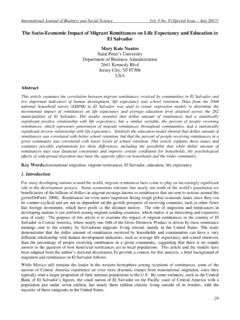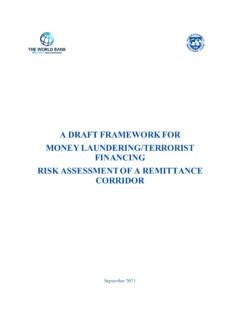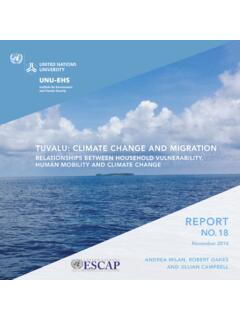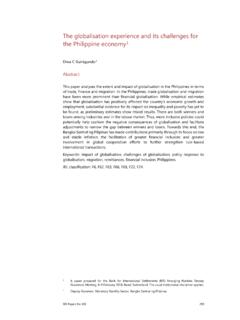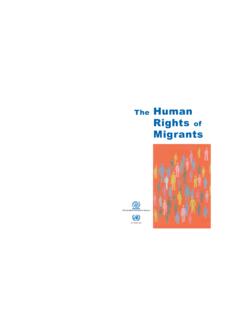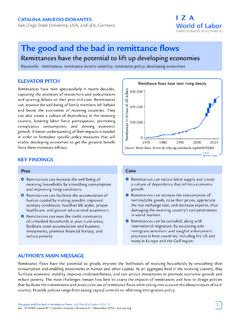Transcription of Migrant Remittances in Africa: An Overview - World Bank
1 1 Remittances are often said to be the most tangible and least controversiallink between migration and development (Russell 1992, Ratha 2007). remittance flows to developing countries have increased substantiallyduring the last decade to reach $325 billion in 2010 ( World Bank 2011). Remittances sent by 31 million international African migrants reachednearly $40 billion in 2010, equivalent to percent of africa s grossdomestic product (GDP).The data on African migration and remittance flows, however, arelikely to be understated because of the scale of undocumented migrationwithin the African continent, the prevalence of informal remittance chan-nels within the region, and the relatively weak official data in manyAfrican countries ( World Bank 2006). The true size of remittance flowsto africa , including unrecorded flows through formal and informal chan-nels, is believed to be significantly larger than the official data.
2 After for-eign direct investment (FDI), recorded Remittances are the Africancontinent s largest source of foreign receipts generate large benefits for the countries of originin africa . The review of the literature and evidence presented in thischapter suggests that Remittances tend to be stable, and often counter-cyclical, compared to other private flows and help to sustain consumptionCHAPTER 1 Migrant Remittances in africa : An Overview Sanket Mohapatra and Dilip Rathaand investment during economic downturns. Cross-country analysis andevidence from household surveys show that remittance receipts are asso-ciated with reductions in poverty, increased household resources devotedto investment, and improved health and education outcomes. Migrantremittances help smooth household consumption and act as a form ofinsurance for African households facing shocks to their income and liveli-hood caused by drought, famine, and other natural disasters.
3 The securi-tization of future remittance flows the use of hard currency remittancesas collateral to raise financing can increase the access of African banksand firms to international capital markets and can be used to fund longer-term development and infrastructure spite of the size, stability, and development implications of thesefinancial flows, this chapter suggests that remittance markets in Africaremain relatively underdeveloped. africa has arguably the largest share ofcross-border Remittances flowing through informal channels, and signifi-cantly higher remittance costs, compared with other, more mature remit-tance corridors (for example, from the United States to Mexico and fromthe Persian Gulf to South Asia). African migrants especially those resid-ing in other African countries and recipient households often havelimited access to formal remittance and banking services.
4 A large share ofinternational Remittances to africa is channeled through a few large inter-national money transfer agencies, which sometimes work in exclusivepartnership with African banks and post broader business and operating environment for provision of remit-tance services is relatively weak in many African countries. At the sametime, the rapid adoption of innovative money transfer and branchless-banking technologies is transforming the landscape for domestic orwithin-country Remittances and potentially broader financial services inAfrica. However, the adoption of these technologies for cross-bordertransfers has been limited so far, in part because of concerns about moneylaundering and terrorist financing related to cross-border money volume represents an effort to better understand the current stateand issues in remittance markets in africa and in selected remittance -source countries.
5 It brings together studies of remittance markets for eightSub-Saharan African countries and in two key Migrant -destination coun-tries outside the African continent conducted as part of the AfricaMigration Project in 2008 10. These studies served as background mate-rial for a joint regional report of the African Development Bank (AfDB)and the World Bank titled Leveraging Migration for africa : Remittances ,Skills, and Investments (AfDB and World Bank 2011).2 remittance Markets in AfricaThe surveys of remittance service providers (RSPs) were implementedby primarily country-based researchers and institutions between 2008and 2009. The country studies cover recent migration and remittancetrends, business environments, services provided to remittance sendersand receivers, remittance costs, and innovations in the remittance market-place.
6 Collectively, these studies provide a unique perspective of RSPsabout their business and operating environment, regulations governingremittance transfers, and innovations in remittance technologies across awide range of African general, the country studies reflect the state of the remittance mar-kets in africa and Migrant -destination countries at the time of the sur-veys. Given the rapidly changing and dynamic nature of remittancemarkets in africa , some of the key facts and trends (such as volumes ofremittances received, subscribers of mobile money-transfer services, andrecent regulatory changes) have been updated to reflect the latest infor-mation available. Many findings of the country studies especially thediscussions of market structure and policy issues are equally or evenmore relevant today in view of the increasing awareness of Migrant remit-tances as a source of development financing for recipient countries andthe international efforts targeted at reducing the cost of Overview chapter outlines the implications of Remittances forAfrica s development and the related policy issues.
7 It sets out the contextfor better understanding the importance of effective functioning of remit-tance markets for the livelihood strategies of African households. Thechapter also shows how Migrant Remittances serve essential consumptionneeds and act as an insurance against adverse shocks; contribute to thefuture productivity of Africans by providing funds for nutrition, educa-tion, and health; and improve their access to formal banking services andinformation and communication technology. In addition, it briefly dis-cusses the implications of Remittances for growth, sovereign creditworthi-ness, and external financing. The chapter s conclusion provides a bridge tothe remainder of the volume and summarizes the 10 remittance -marketcountry Overview chapter and country studies paint a nuanced picture ofnot only the opportunities but also the many obstacles still to be over-come in the quest for providing affordable and transparent remittanceand broader financial services to the poorest in africa .
8 The cost of send-ing Remittances to africa , and especially within africa , is among the high-est among developing countries. The market for cross-border remittancesMigrant Remittances in africa : An Overview3in africa continues to be characterized by a high degree of informality,lack of effective competition, exchange controls on outward transfers, andoften-exclusive partnerships of international money transfer companieswith local banks and post offices that contribute to high costs and restrictmarket entry and competition. At the same time, the widespread adop-tion of mobile money transfers for domestic Remittances represents asuccess story of how africa has effectively leapfrogged the technologyfrontier to design and deliver technology solutions targeting the rest of the Overview is organized as follows. We first discuss recenttrends and prospects for migration and Remittances in africa .
9 Next, weexamine the implications of Remittances for growth and access to exter-nal finance of African countries. The section on implication of remittancesfor the welfare of African households draws on the literature and recenthousehold surveys. The subsequent section reviews Remittances costs,competition, legal and regulatory environments, and technological inno-vations in African remittance markets. We then discuss recent policy ini-tiatives and outline some policy options for better leveraging remittancesfor africa s development. The final section summarizes the studies ofeight remittance markets in Sub-Saharan africa (chapters 2 9 of this vol-ume) and two key destination countries of African migrants : France andthe United Kingdom (chapters 10 11 of this volume).Recent remittance Trends in AfricaMigrant Remittances have become an important source of externalfinance for the African continent.
10 Officially recorded remittance flowsto africa , as shown in figure , are estimated to have increased from$ billion in 1990 to nearly $40 billion in 2010 (divided roughlyequally between North africa and Sub-Saharan africa ). The true size ofremittances, including unrecorded flows, is believed to be significantlyhigher. Remittances to africa equaled percent of GDP in 2009, higherthan the average of percent of GDP for all developing remittance flows to the African continent are several timeslarger than official aid to North africa ( percent versus percentof GDP) and almost 60 percent of the size of official aid flows to Sub-Saharan africa , as table shows. For many low-income African coun-tries, Remittances exceed private investment flows and represent alifeline to the few countries account for a substantial share of Remittances to Sub-Saharan africa and North africa .










